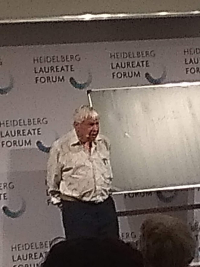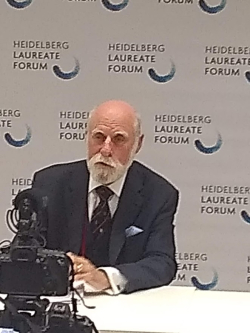
He has a new theory about it.
Smale turns 90 next June, and is the oldest Heidelberg Laureate at this year’s Forum. But he’s also one of the most active, in a purely academic sense.
For his recent work, a mathematical theory of the human heartbeat, Smale started with Huygens’ description of a diffusion force, which causes two pendulums on a beam to beat together. Then he took a theory from Alan Turing on morphogenesis , concluding his solution was too linear, not dynamic enough. He added two hypotheses, monotonicity rom computer science and a hard-wiring hypothesis, from brain science.
“This is the beginning of a model for the heartbeat,” he said, moving slowly to a blackboard. The blackboard’s presence was the first sign of his age. While other speakers had used notes or PowerPoint decks, Swale was going from memory, only writing equations to illustrate the path.
Smale went through a Laplacian diffusion applying both traditional mathematics and computer science. Within a half-hour had his audience understanding “a complete picture of the dynamics,” adding a Koramoto flow equation and Morse theory to “help us understand the complete dynamical picture” for the flow, and a picture of the phases.
Smale won the Fields Medal in 1966. His acceptance of the Medal, in Moscow, became a huge Cold War controversy. Smale won the Wolf Prize in Physics in 2007.
The Fields Medal goes to mathematicians for work before they turn 40. After that, it’s assumed, they start going over the hill.
Stephen Smale has yet to see that hill, let alone go over it.










